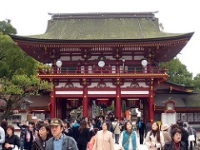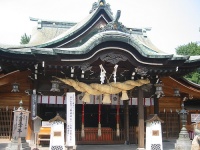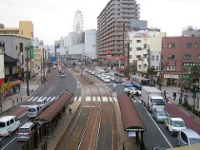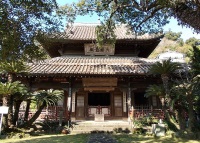
In the northern part of Kyushu Island in southwestern Japan lies the ruins of Dazaifu, a city that during the 1st century was the seat of government for the island and first line of defence against threat from East Asian nations. The walled city once stood in open fields, but now the ruins on the southern slopes of Mount Ono are surrounded by modern Dazaifu, and the valued historic site has been turned into a park. Apart from the interesting ruins, Dazaifu also boasts one of Japan's most important shrines: the Dazaifu Tenman-gū is dedicated to a great scholar named Sugawara Michizane, who died in the year 903 and subsequently became revered as a deity because of his wisdom. The shrine is now a place of pilgrimage for students from all over the country, especially when examination season comes around. The approach to the shrine is lined with teahouses specialising in a local rice cake delicacy, which is believed to keep illness at bay. The ancient Komyozenji Temple, situated close to the shrine, is also worth a visit, mainly for the stunning gardens, which are particularly beautiful in the autumn when the leaves turn a magnificent array of colours.

Fukuoka's Asian Art Museum is housed in a new complex in the Shimokawabata district of Hakata Ward, in the heart of the city. The museum houses a collection of more than 1,000 works including paintings, sculptures, prints, and handcrafts. It also serves as a centre for art education. This popular modern museum offers a wide array of contemporary Japanese art and art from many other Asian countries. If you are lucky, you will even get the chance to watch some local artists at work in the museum. It is a small museum but gives an impressively comprehensive overview of current trends in the region. The permanent collection is wonderful and should appeal both to the uninitiated and those well-versed in Asian art. There are regular temporary exhibitions and special events as well. There is a lovely little cafe attached to the museum, which is particularly nice on sunny days when visitors can sit outside. There is also a gift shop with gorgeous postcards, prints, and books for souvenirs, and a children's play area to keep the kids occupied. The museum is situated in an interesting part of town, and it is fun to stroll around the area and explore a bit after your visit.
Address : Riverain Complex, 3-1 Shimokawabata-machi, Hakata-ku
Website : faam.city.fukuoka.lg.jp/eng/home.html

One of Fukuoka's best-known shrines is Kushida, founded in 757. It is situated in the heart of ancient Hakata with a huge gingko tree, said to be 1,000 years old, shading its forecourt. The shrine honours the grand deity, Ohata Nushina-mikoto, and was built during the Heian Period for the common people. Today it is very much enjoyed by locals and visitors alike during the summer's major event, the Hakata Gion Yamakasa Festival. On the last day of the festival, the Kushida Shrine becomes the starting point for this fun run where hundreds of young men clad only in loin cloths carry heavy wooden shrines through the streets along a set route, vying to clock the fastest times. The shrine itself contains several items of interest, particularly the Eto Arrow plate bearing carvings of the Chinese zodiac and a brace of anchor stones, recovered from the harbour, that were once attached to ships of the Mongolian invasion fleets. The Hakata Historical Museum is also situated in the shrine grounds, which are pretty and well-kept. There is lots of shopping and many food stalls to enjoy in the area and the shrine complex is great for a stroll, a rest, some meditation, and some historical sightseeing.
Address : 1-41, Kamikawabatamachi, Hakata-ku
The composite volcano of Mount Aso lies almost in the centre of Kyushu Island. Among the largest in the world, it's also Japan's biggest active volcano. Mount Aso also boasts one of the world's largest caldera (volcanic depressions), which stretches about 11 miles (18km) from east to west and 15 miles (24km) from north to south. Inside the caldera are five volcanic peaks: Mount Neko, Mount Naka, Mount Eboshi, Mount Taka, and Mount Kishima. Mount Naka is still active and regularly emits smoke and ash. The rest of the landscape inside the caldera is beautifully green and grassy, with grazing cows and horses, as well as about 50,000 inhabitants in several towns and villages. In the city of Aso there is a museum dedicated to the volcano which is worth visiting for those interested in the region's remarkable geology. At the museum visitors can watch presentations about Aso in addition to viewing a live image from a camera positioned at the active crater site. There is a cableway up to the Mount Aso crater lake, called the Mount Aso Ropeway, which allows visitors to see the steaming turquoise water up close. But when the sulphur level rises too high the site is closed as the fumes can become toxic.

The beautifully situated port city of Nagasaki lies at the southern end of Kyushu Island, 95 miles (152km) southwest of Fukuoka. Nagasaki was open to the world for centuries between 1639 and 1859 while the rest of Japan was secluded from foreign contact by governmental decree. The exposure to foreign cultures has left the city with a sophisticated and liberal air that makes it popular for tourists, enhanced by the many attractions in the city itself and surrounding prefecture. Here you can enjoy Feudal castles, samurai houses, smoking volcanoes, hot spring baths, rugged offshore islands, and beautiful beaches. The most important site in the city is the Peace Park (Heiwa Koen), commemorating Nagasaki's darkest hour on 9 August 1945, when a nuclear bomb intended to be dropped on the Mitsubishi Shipyards exploded instead over the Urakami district, killing approximately 80,000 people. A black stone column marks the blast's epicentre, alongside the Atomic Bomb Museum. Nagasaki has many attractions for visitors and one of the most popular short excursions is a boat trip to the spooky Hashima Island, once a coal mining facility but now completely uninhabited and covered in ruins.

The Shofukuji Temple was the first Zen temple to be built in Japan. It was founded in 1195 by the priest Eisai who introduced the Rinzai sect of Zen Buddhism into Japan from China. The wooden buildings have been destroyed and rebuilt many times over the centuries but they are exact replicas of the original structures. In the temple grounds are the remains of two other ancient temples, Jotenji and Tochoji, as well as a number of other structures. Unfortunately, the ancient buildings cannot be entered but visitors can explore the lovely grounds and examine the exteriors. Photography is welcome. Although the temple complex is a historic and ancient site, it is not frequented by tourists and is seldom crowded, although locals do visit regularly. As a result, it is a peaceful and serene place which affords a nice break from the busy city; the age and history of the temple is almost palpable. It is a lovely spot for a walk or rest and there is a lot to see in the complex, although there is little information provided on what you are seeing.
Address : 6-1 Gokuso-machi, Higashi-ku

Travel Guide powered by Word Travels, copyright © 2023 Globe Media Ltd. By its very nature information in this travel guide is subject to change at short notice and travellers are urged to verify information on which they're relying with the relevant authorities. Neither Globe Media Ltd nor Travel Vogue can accept any responsibility for any loss or inconvenience to any person as a result of information contained above.